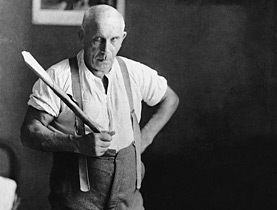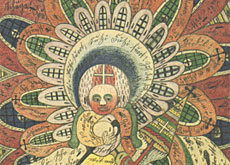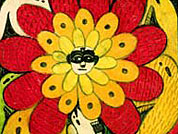Portrait of the madman as an artist

An exhibition at Bern's Fine Arts Museum is showing the work of a convicted paedophile and schizophrenic, Adolf Wölfli, who started drawing as a psychiatric patient.
swissinfo went to Waldau, the psychiatric clinic on the outskirts of the Swiss capital where he was treated, to find out whether his mental illness was the key to his creativity.
Wölfli, a labourer from canton Bern, has been revered for decades as an exponent of Art Brut or Outsider Art.
French artist Jean Dubuffet coined the term to describe art beyond fine art, created by the likes of the mentally incapacitated and prisoners. International collectors of Wölfli’s work include musician David Byrne and actor Robin Williams.
Found guilty of sexual acts with minors and suffering from schizophrenia, Wölfli was sent to Waldau in 1895. He spent more than 30 years there until his death in 1930.
Four years into his incarceration, Wölfli began to draw, encouraged by his psychiatrist, Walther Morgenthaler. The patient filled more than 25,000 pages with illustrations, texts and musical pieces, which were bound into huge tomes.
Two large stacks are currently on view at the Kunstmuseum in Bern as part of a retrospective entitled “The Universe of Adolf Wölfli”, as well as more than 150 works.
Creative madness?
As to what extent the patient’s creative abilities were influenced by his mental condition, the link is sometimes not clear, according to Andreas Altorfer, curator of Waldau’s Psychiatry Museum.
“His illness is not always apparent in drawings but in the texts there are strange combinations of words and thought disorders are visible,” Altorfer told swissinfo.
He added that the drawings are “very ornamental with a lot of signs; it’s a special style but you would not immediately see that it was produced by a mentally ill patient”.
Wölfli also wrote a series of books, reinventing his childhood. Instead of mentioning truths, including physical hardship and the loss of his parents as a child, his fantasy early-life included globetrotting and fabulous wealth. In one narrative, he calls himself St Adolf II.
Altorfer agrees, however, that Wölfli’s psychiatric illness did help him indirectly as an artist and writer.
“[Being at Waldau] gave him the chance to be creative. He wouldn’t have had this opportunity in another setting outside the hospital,” he said.
“Outside, you had to work very hard and if you have to milk cows, you didn’t have time for creativity,” Altorfer added.
Earning bread
Nearly all of Wölfli’s work is on paper and often filled with swirling lines, small faces with bushy eyebrows, birds, ornamental bands and different shading styles. The early works are all in lead pencil. Later, colour explodes from his illustrations, in particular his so-called “Brotkunst” or “bread art”.
Wölfli sold many of these single sheets to finance a steady supply of art materials. As news of his talents spread outside the hospital, presumably thanks to its staff, he received commissions, some of which required him to decorate wardrobes with his distinctive style.
It was samples of Brotkunst that Morgenthaler published in his book, “Ein Geisteskranker als Künstler”, which was about this creative inmate.
Loosely translated as “A mentally ill person as an artist”, the publication caused shockwaves across the art world. It was 1921 and the first time that the work of a psychiatric patient had been considered art.
swissinfo, Faryal Mirza
Wölfli apparently had a troubled childhood. He suffered abuse and molestation and was orphaned at the age of 10, growing up afterwards in foster care.
He worked as a farm labourer and briefly joined the army but was later convicted of attempted child molestation for which he served prison time.
After his release, he was arrested again for a similar offence and was admitted in 1895 to the Waldau clinic.
Reports from that time say he was very disturbed and sometimes violent on admission, leading to him being kept in isolation early on. His problems were believed to be related to his psychosis, which led to intense hallucinations.
At some point after his admission Wölfli began to draw. His earliest drawings did not survive, so it is difficult to know exactly when he began his artwork. His first known works are dated from between 1904 and 1906.
In 1908 he also began a semi-autobiographical epic that eventually stretched to 45 volumes, containing a total of over 25,000 pages and 1,600 illustrations.
This work was a mix of elements of his own life blended with fantastical stories of his adventures. Text and illustrations formed the narrative, sometimes combining multiple elements on kaleidoscopic pages of music, words and colour.

In compliance with the JTI standards
More: SWI swissinfo.ch certified by the Journalism Trust Initiative


You can find an overview of ongoing debates with our journalists here. Please join us!
If you want to start a conversation about a topic raised in this article or want to report factual errors, email us at english@swissinfo.ch.